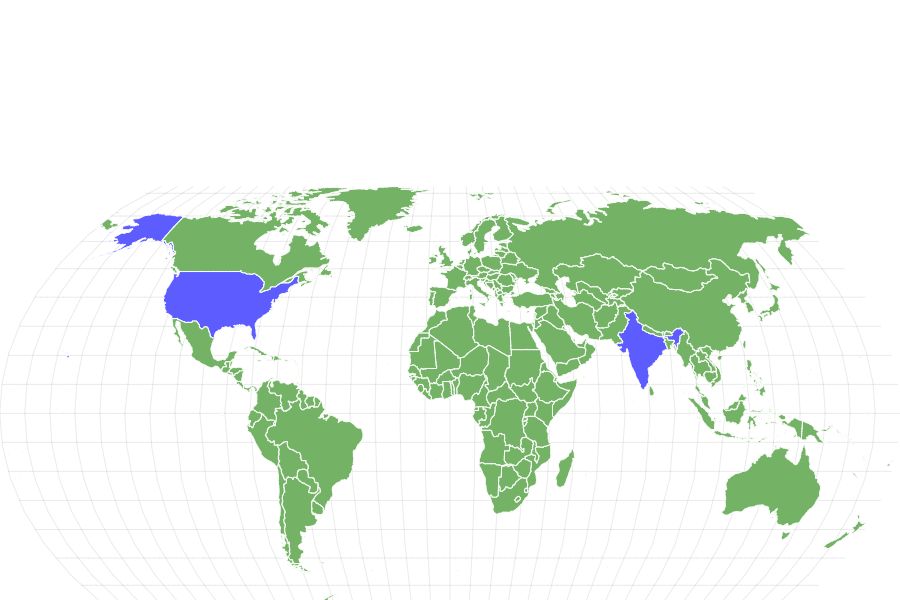Nilgai
Boselaphus tragocamelus
Nilgai were hunted for their meat as far back as 8,000 years ago.
Advertisement
Nilgai Scientific Classification
- Kingdom
- Animalia
- Phylum
- Chordata
- Class
- Mammalia
- Order
- Artiodactyla
- Family
- Bovidae
- Genus
- Boselaphus
- Scientific Name
- Boselaphus tragocamelus
Read our Complete Guide to Classification of Animals.
Nilgai Conservation Status
Nilgai Facts
- Name Of Young
- calf
- Group Behavior
- Social
- Fun Fact
- Nilgai were hunted for their meat as far back as 8,000 years ago.
- Estimated Population Size
- At least 250,000
- Biggest Threat
- Excessive hunting, but its conservation status is least concern.
- Most Distinctive Feature
- The bull’s bluish-gray coloration
- Other Name(s)
- Blue bull, white-footed antelope, south Texas antelope
- Gestation Period
- 8.4 months
- Litter Size
- Usually two, sometimes one or three calves
- Habitat
- Dry areas such as prairies and scrub forest
- Predators
- Humans, tigers, leopards, wolves, dholes, striped hyenas
- Diet
- Herbivore
- Type
- mammal
- Number Of Species
- 1
- Location
- Indian subcontinent, Texas
- Group
- Herd, segretated by sex
Nilgai Physical Characteristics
- Color
- Brown
- Grey
- Yellow
- Blue
- Light-Brown
- Skin Type
- Hair
- Top Speed
- 29 mph
- Lifespan
- 21 years
- Weight
- 264 to 634 pounds
- Height
- 47 to 59 inches
- Length
- 71 to 79 inches
- Age of Sexual Maturity
- About three years for females, 4 years for males
- Age of Weaning
- 10 months
View all of the Nilgai images!
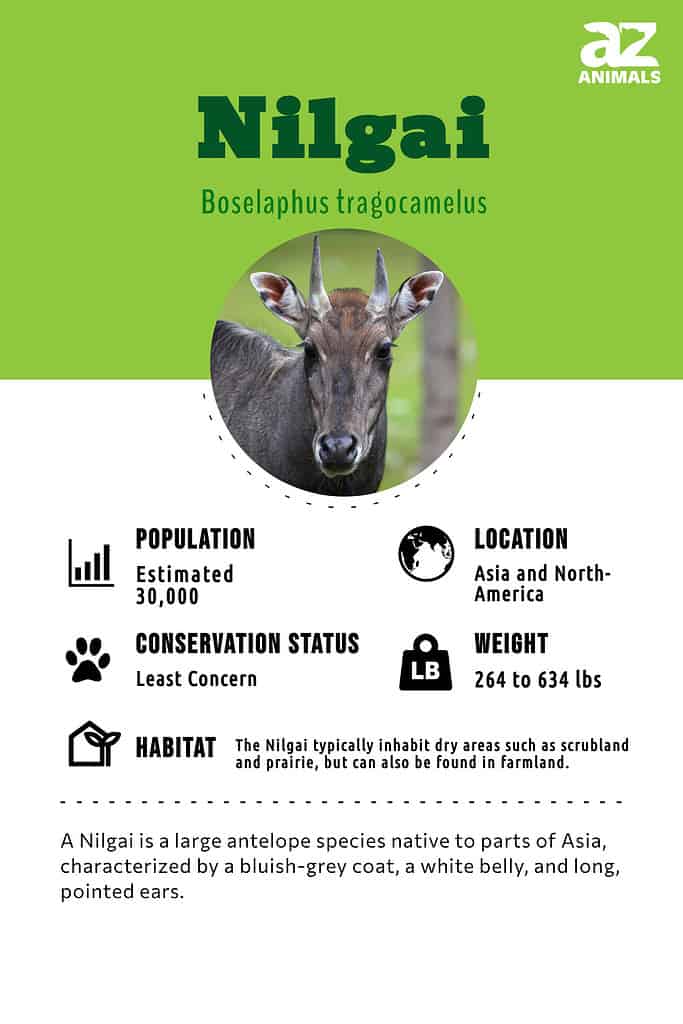
“The largest Asian antelope.”
Nilgai means “blue cow” in Hindi and describes the lovely bluish-gray color of the male’s coat. It’s not only the biggest antelope found in Asia, it’s one of the oldest species of antelope in the world. Scientists believe that this big-bodied animal with its slender legs showed up as long as 5 million years ago and hasn’t changed much since. Read on for more information about the nilgai.
Four Amazing Nilgai Facts
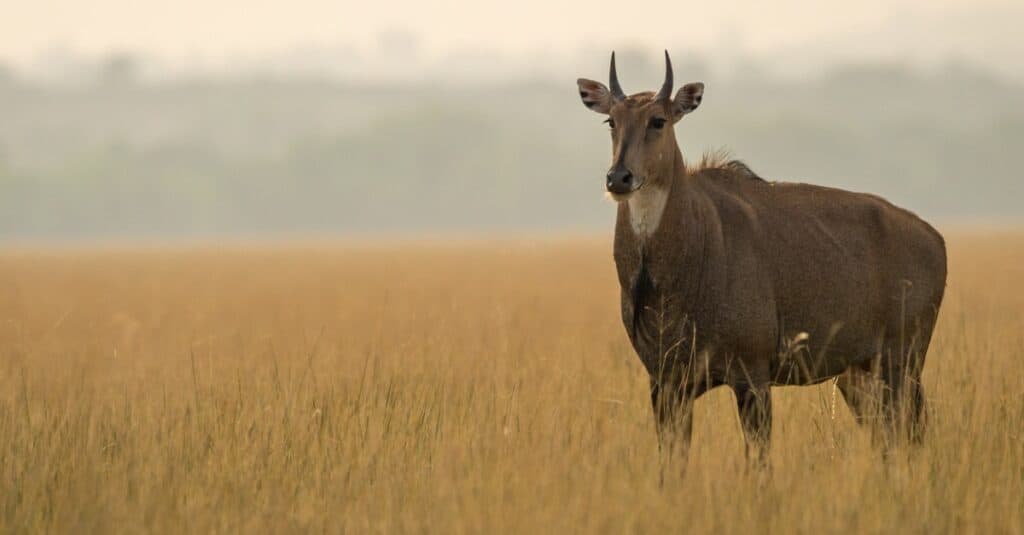
During the 1920s and 1930s, an animal from Asia was introduced to Texas ranches for the purpose of hunting. However, a few of these animals managed to escape and as a result, a wild population of nilgai now exists in Texas.
©iStock.com/Sourabh Bharti
Here are four amazing facts about the nilgai:
- They are so plentiful that they’re listed as pests in some parts of India.
- The nilgai is the only member of the Boselaphus genus.
- This Asian animal was brought to Texas ranches in the 1920s and 1930s for game hunting, but some escaped. There is now a feral population of nilgai in Texas.
- The nilgai’s healthy numbers are at least partly due to the fact that practitioners of the Hindu religion consider the antelope sacred and won’t kill or eat it.
Scientific Name
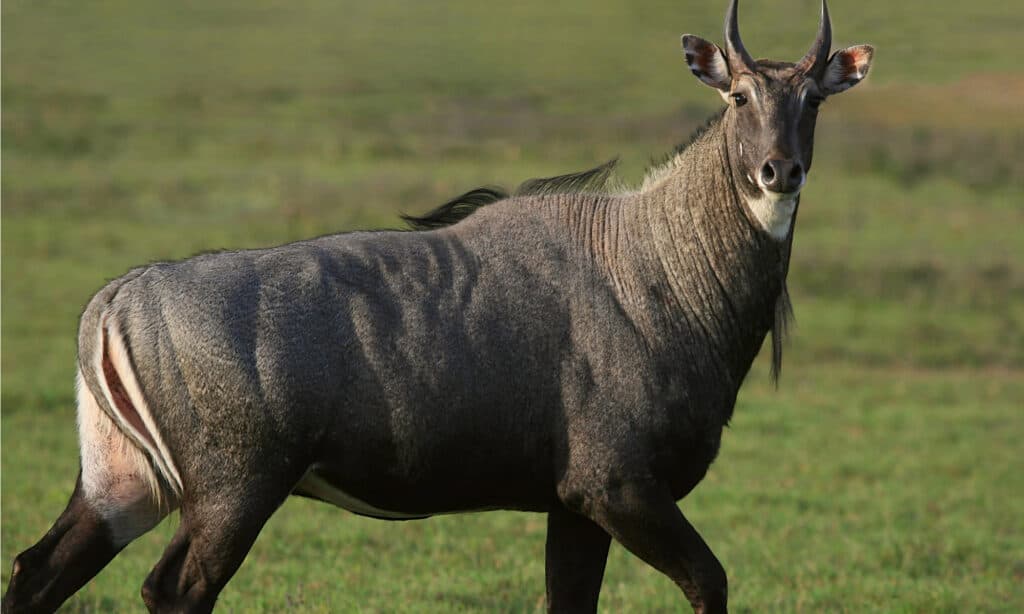
The nilgai is scientifically known as Boselaphus tragocamelus. The name Boselaphus is a combination of the Latin word “bos”, meaning cow, and the Greek word “elaphos”, meaning deer.
©Raymond Pauly/Shutterstock.com
The scientific name of the nilgai is Boselaphus tragocamelus. Boselaphus comes from the Latin word for “cow” which is bos and the Greek word for “deer” which is elaphos. Tragocamelus combines the Greek words for “billy goat” and “camel,” which are tragos and kamelois respectively. There are no subspecies of the nilgai, and it is only found naturally on the Indian subcontinent. The name nilgai is Hindi for “blue cow.”
Evolution and Origins
It seems that the nilgai antelope (Boselaphus tragocamelus Pallas) were originally transported from India to the United States as zoo specimens prior to the mid-1920s, and were subsequently released in South Texas around 1930. The term “nilgaw” in Hindi, which means “blue bull,” refers to the bluish hue of the male adult and is another moniker for this animal.
Fossil records show that this type of antelope lived in North America during prehistoric times, as early as the late Miocene. The two antelope species in this group are more closely related to the earliest bovids (like Eotragus species) than to other bovids.
This group appeared at least 8.9 million years ago, in the same area where the four-horned antelope lives today, and may be the least changed of all living bovids, having remained similar to their ancestors since the beginning of the family.
Appearance
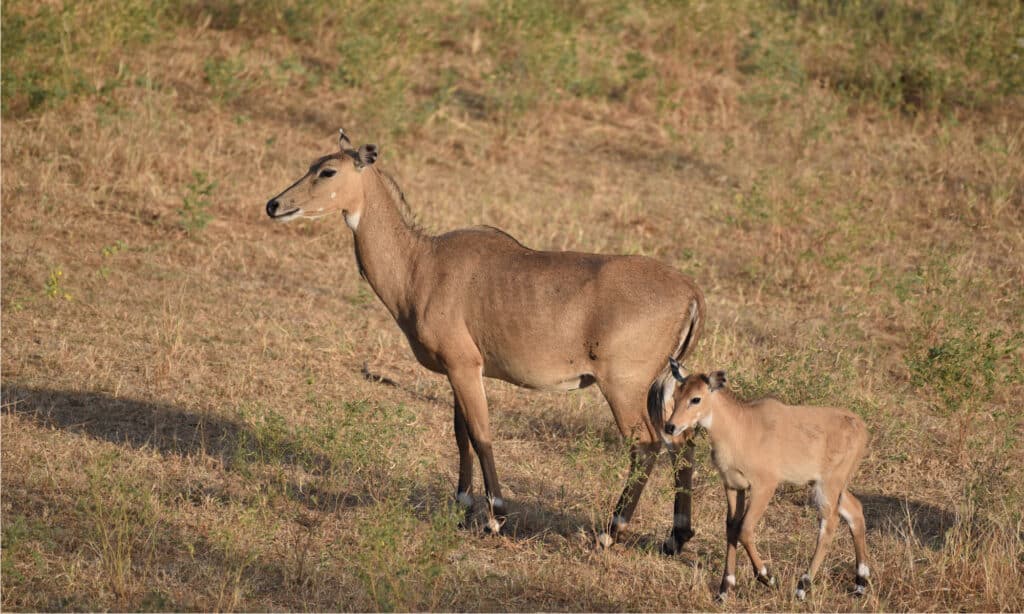
The nilgai, which is the largest antelope species in Asia, can grow up to 4.9 feet in height at the shoulder, 6.58 feet in length, and weigh as much as 634 pounds.
©Sajeev Bhaskaran/Shutterstock.com
The biggest of the Asian antelopes, the nilgai can be as much as 4.9 feet high at the shoulder, 6.58 feet long, and weigh up to 634 pounds. Males are bigger than females and stand out because of their blue-gray coats. The coat of the females is tawny. In both males and females, the coat is short, rather thin, and doesn’t offer much protection from the cold. Even nilgai found in Texas can freeze to death from an unexpected cold snap.
The antelope is also noted for the slenderness of its legs, which resemble those of a deer or a horse. Like some horses, the legs of some nilgai have “socks.” The animal has a down-sloping back and a thick neck that sports a white patch. Both sexes have a mane that runs down the neck and just past the shoulder. The face, ears, lips, cheek, and chin each have two white spots, and the ears have black tips.
The tail also has white spots and a black tip. Males have a pendant or beard beneath the white patch on the throat. Their bodies are heavily built, and males have very thick skin on their neck and head that serve as a sort of dermal armor.
The nilgai’s head is disproportionately small when compared to the robust body and bears short, sharp horns that can be straight or a bit curved. They are also different from the horns of other antelope in that they are smooth and lack rings. Only the males have horns.
The animal’s hearing and vision are good, but it doesn’t seem to have a sharp sense of smell.
Behavior

The nilgai is diurnal, meaning it is active during the daytime. Typically, they tend to gather in herds of no more than 10 individuals.
©Sudip Adhikary/Shutterstock.com
Nilgai is active during the day. They most often form herds of 10 animals or less. These herds can be made up of one or two mothers with their younger calves, mothers with calves and yearling females, or made up only of males. Nilgai is rather timid and quiet, though they’ve been heard to roar when they’re frightened. Both males and females fight and calves play fight.
Fights between males during the mating season can get bloody. The antelope creates dung piles, for it is careful to defecate in the same place all the time. Biologists don’t know why this is, but nilgai dung piles enrich the soil, and the seeds that survive digestion sometimes germinate.
Habitat

The nilgai has a preference for dry habitats such as scrublands and prairies, although it is also known to reside in farmland where it feeds on crops, much to the disappointment of many farmers.
©Dmitry Rukhlenko/Shutterstock.com
The nilgai prefers dry areas such as scrubland and prairie. To the dismay of many farmers, it will also live on farmland and eat the crops. The animal is endemic to the Indian subcontinent and can be found from the foothills of the Himalayas to southern India.
Diet
Nilgai is herbivores and spends much of their day eating and digesting. They mostly eat grasses during the rainy season but supplement their diet with flowers, seeds, pods, leaves, and herbs such as euphorbia. If these foods are scarce, the nilgai is tall enough to reach into the higher branches of trees for their leaves. This gives them an advantage over smaller artiodactyls like deer. Though the animal doesn’t need a great deal of water, it will leave an area that’s undergoing a drought in search of a good water source.
Nilgai that lives in Texas readily eats mesquite, plants in the nightshade family, and native grasses.
Predators and Threats
Besides humans, animals that prey on the nilgai include wolves, striped hyenas, leopards, dholes, and tigers. Most of these animals, save the leopard and the tiger, take baby nilgai as adults are too large to handle and can run fairly fast if they sense danger. Other threats to the nilgai are habitat degradation.
Reproduction and Life Cycle
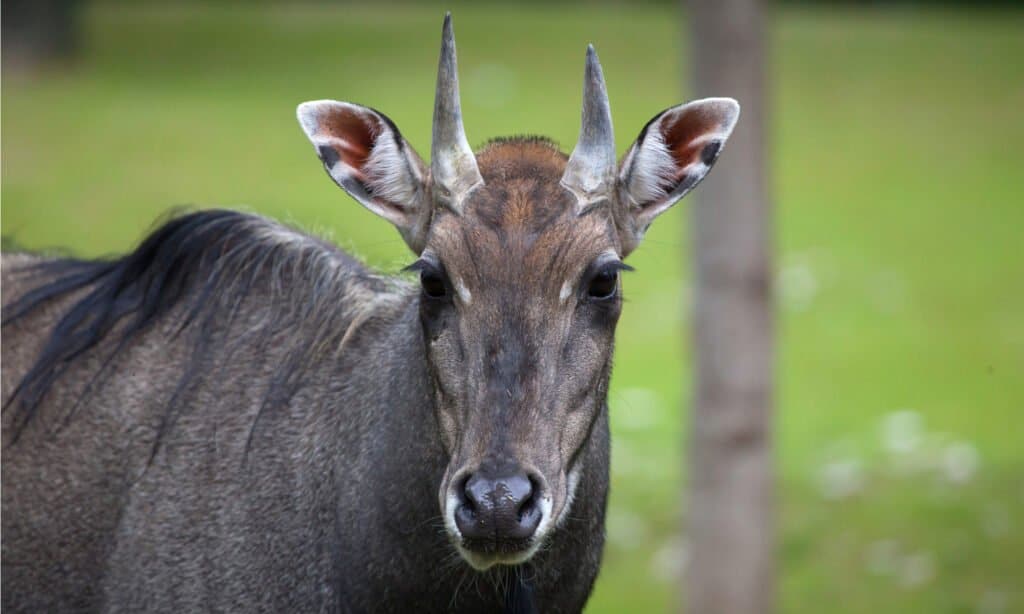
Although the nilgai is capable of breeding throughout the year, they typically mate from December to March in Texas and from October to February in India.
©Vladimir Wrangel/Shutterstock.com
Nilgai can breed any time of the year, but they usually breed from December to March in Texas and from October to February in India. During the breeding season, the males join the female herds. Bulls don’t seem to be territorial, but they challenge each other and sometimes fight for breeding rights.
Sometimes the fights are so violent that a bull is injured or even killed, and though bulls are ready to reproduce when they’re about two and a half, they usually don’t get to mate until they are around four years old and can challenge older bulls. Eventually, after the challenges and the fighting, one bull has a harem of cows. The courtship ritual lasts about three-quarters of an hour.
The female is pregnant from eight to nine months. When it’s time to give birth she leaves the herd. She’ll usually give birth to twins who are able to stand up within an hour of birth and eat solids when they’re about a month old, though they’re nursed until they are 10 months old. Their mother makes sure they are hidden for as long as a month before they join the rest of the herd. Concealing a new baby for a period of time is a common strategy for bovids. When the male calves are weaned, they go off to join bachelor herds.
Though Texas nilgai lives for about 10 years, the lifespan of nilgai, in general, can be as long as 21 years.
Population
The nilgai population in the Indian state of Gujarat is at least 250,000 as of 2022, an increase of 117 percent over the 2011 population. Additionally, there are about 15,000 of these antelopes in Texas. The antelope’s conservation status is least concern, but they are protected in Gujarat.
View all 65 animals that start with NNilgai FAQs (Frequently Asked Questions)
Are nilgais carnivores, herbivores, or omnivores?
Nilgais are herbivores. They prefer grasses but will also eat leaves, seeds, stems and flowers. They also eat crops if they’re found on farmland.
What is a nilgai?
A nilgai is a large antelope that’s only found in the wild in India and Nepal. It is a very old and primitive type of antelope and may have arisen as far back as the late Miocene epoch, which was about 5 million years ago.
Is nilgai good eating?
The nilgai seems to be good eating. People who’ve tasted the meat claim that it has a mild flavor and is lean like venison or veal. The meat of a cow is more tender than the meat of a bull.
What is special about nilgai?
What’s special about the nilgai is that it’s Asia’s largest antelope. It has also adapted very nicely to the habitat of Texas even though it evolved in the Indian subcontinent.
How many nilgai are in Texas?
There are probably around 15,000 nilgai in Texas. These are animals that are found on ranches. Biologists believe that there are also a feral populations of the animal.
Is nilgai a cow?
A nilgai is not a cow, but a type of antelope. It is related to the cow in that both belong to the Bovidae family.
How did nilgai get to Texas?
The nilgai were first brought to Texas in the 1920s and ’30s for the purpose of hunting.
Thank you for reading! Have some feedback for us? Contact the AZ Animals editorial team.

